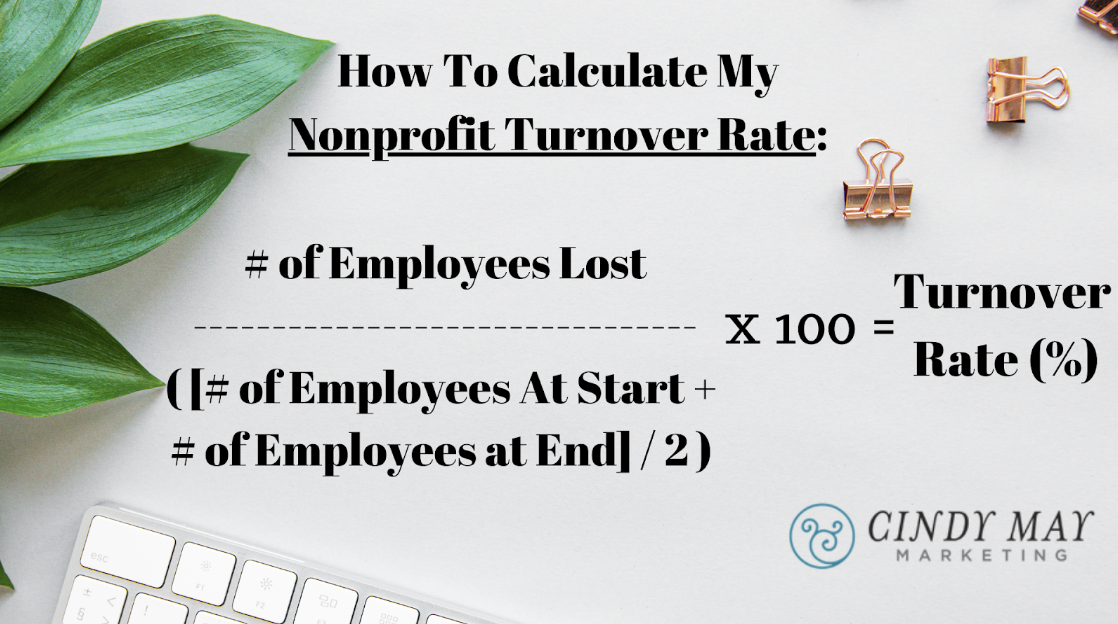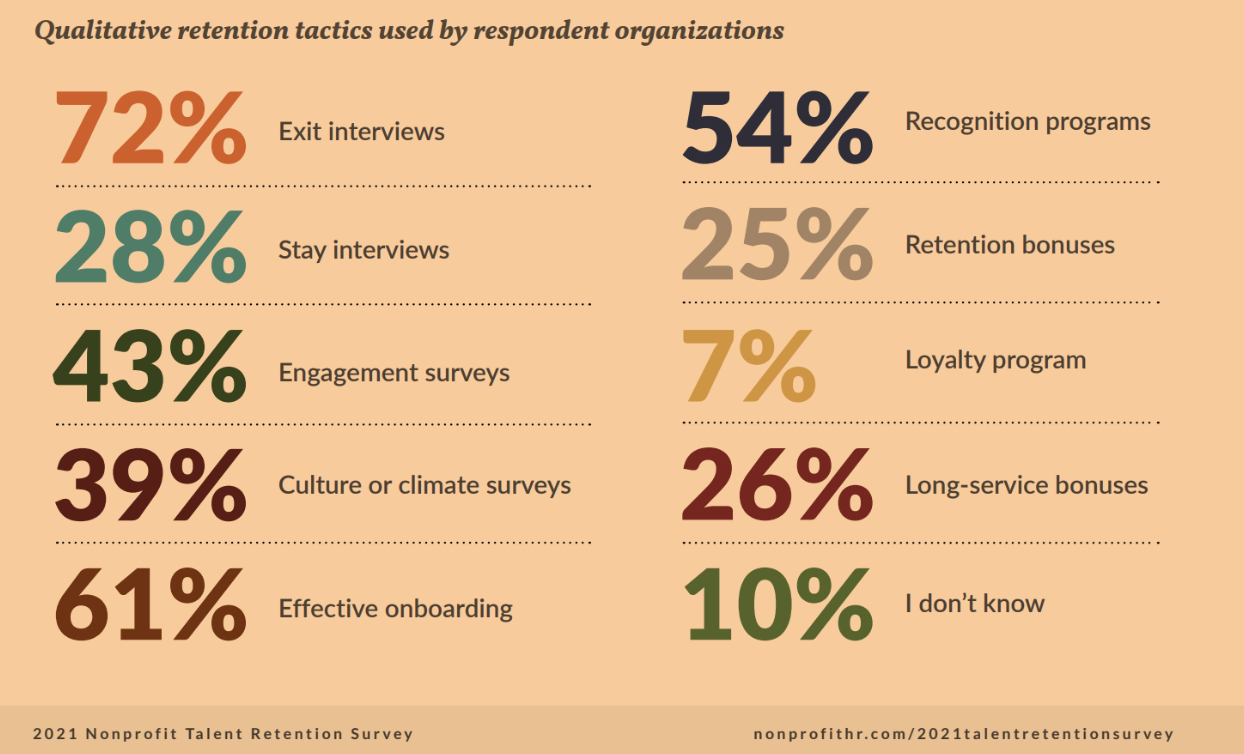Nonprofit Turnover: What It’s Costing You and What To Do About It
Jun 09, 2022
Employee retention among nonprofit organizations is a genuine challenge. But then, so is employee retention among private businesses. In fact, the situation is not as dire as you have been led to believe.
Nonprofit Turnover Is High (But Not As High As You Think)
When you Google “Nonprofit Turnover Rates,” you will find one commonly recurring statistic: “The voluntary annual turnover rate for nonprofit’s is 19% — far outpacing the all-industry average of 12%.”
Fortunately for you, this figure isn’t quite accurate. First, it’s a bit outdated (drawn from the 2016 Nonprofit Employment Survey Report). Second, that figure has been misinterpreted by a number of blogs and articles online. Turns out, that 19% actually pertains to total turnover, rather than voluntary turnover.
In terms of the tru voluntary turnover rate, the responding organizations reported an average of 13% in 2015. And according to the 2015 CompData Survey, it appears to have actually been less than that (11.6%).
Fast forward to the last few years. According to a much more recent data set, Nonprofit HR’s research pointed to a decrease in the overall turnover of social impact organizations, from 21.3% in 2019 to 14.3% in 2020. If we look at just voluntary turnover, it’s a decrease from 16.7% to 10.9%.

It seems despite the volatility of the pandemic and the “Great Recession” that now besets us, people may actually be more willing to devote their time and effort to jobs that allow them to make a difference. That’s why many are leaving their jobs in the first place after all - the pursuit of more fulfilling and meaningful employment.
Nevertheless, voluntary separation from jobs is still on the rise across the U.S., in all sectors.
It’s 10 PM, Do You Know What YOUR Turnover Is?
Clearly there’s a lot of conflicting information about average annual nonprofit turnover rates. So instead of focusing on the sector as a whole, the best thing to do is track your specific organization’s turnover to determine if you’ve got inordinate issues with employee retention that need to be addressed.
According to the 2021 Talent Retention Practices Survey from Nonprofit HR, almost one-third (30%) of the responding nonprofits revealed that they do not track their own turnover rates. That number jumps up to 62% in regards to how many do not keep track of first-year resignations, and all the way up to 79% when it comes to those not tracking “regrettable” resignations of high-performing staff.
Let’s tackle that first one, for starters.
How To Calculate My Turnover Rate
Don’t worry, the math is simple:
- Decide the period of time you wish to examine. Is it a month? A quarter? A year?
- Determine the amount of employees that separated from your organization (voluntarily, involuntarily, or both) during that time.
- Determine the number of employees at the beginning and end of that time.
- Then plug those three numbers into the equation below:

Just like that you’ve started tracking a new and vital organizational metric. As you move forward, keep a running spreadsheet to make future calculations easier, as well as to track additional employment metrics like the two others listed above.
But this is just the beginning. Without personally collecting quantitative data on hiring, firing, and quitting, it is impossible to understand the bigger problem at hand. Namely…
The True Cost(s) Of Turnover
Here’s a hint: it’s higher than you think.
Understanding the short-term and long-term costs is crucial. It’s also a challenging cost to truly apprehend and acknowledge. That’s probably why only 16% of the organizations from the above 2021 survey said they tracked the cost of turnover.
After all, in order to accurately calculate the financial costs of losing and replacing an employee, you need to know quantifiable figures like:
- Estimated costs for advertising/promoting the job opening online
- Estimated managerial time cost spent reading resumes, conducting interviews, and reviewing candidates (times the number of staff involved in that process)
- Costs of new candidate assessments
- Costs of onboarding and training new employees
- Lessened and lost productivity due to an empty position (times however long it takes to fill that position)
And that’s not even taking into consideration the more qualitative (but still very real) costs to your organization, including:
- Lowered morale and diminished engagement
- Decreased productivity and increased burnout due to extra work for remaining staff
- Necessary postponement of organizational goals
- Decreased customer/client service and satisfaction
- Loss of expertise
Both lists go on from there, but you get the idea. If you want to take a first look into what your specific turnover costs are, you’re in luck. The Nonprofit Leadership Alliance created a very useful "Cost Of Employee Turnover" Calculator to get you started.
In short, though: Losing an employee is costly, regardless of the reason for separation. Having an empty position within your organization is costly. Hiring a new candidate is costly. Getting a new employee up-to-speed is costly.
To minimize those costs, you must decrease turnover rates. And the first step toward that goal is to figure out…
Why Nonprofit Employees Quit
There are a myriad of factors behind why people leave nonprofit jobs. Here are some of the primary reasons for voluntary turnover in respondent nonprofit organizations (2021 Talent Retention Survey):
- 49% - Better opportunity presented
- 44% - Lack of upward mobility
- 35% - Dissatisfaction with or disengagement from current organization/culture
- 32% - Compensation or benefits
- 19% - Career change
- 10% - Lack of professional development
Remember, however, that these reasons are the averages of survey responses. They may or may not pertain to your particular situation. The saying “statistics mean nothing to the individual” is a slight exaggeration, but there is some truth there.
That’s why you’ve got to do some digging into your own organizational employment trends, to figure out why your employees leave and how you may be able to persuade them to stay.
Nonprofit Employee Retention Best Practices
- Send a Staff Survey - Email a carefully considered, open and honest questionnaire to get a sense for the satisfaction (or lack thereof) of your staff. Ask them directly how they’re feeling about their responsibilities and contributions, what they think of the organization’s goals and achievements, what, what’s not, and what they would change if they could. Be sure that responses are anonymous, so you (hopefully) receive honest answers.
- Do a Compensation Review - Find out how your pay and benefits measure up to other nonprofits. Additionally compare compensation of positions within your organization to the compensation of same/similar positions in the private sector. That way you’ve got a better idea what you’re competing against, and who to prioritize should the opportunity (and funding) to increase salary arise. The Bureau of Labor Statistics provides an excellent resource for this.
- Facilitate Personal Development - Find ways to help your staff expand their skills, broaden their experience, and even move up in the organization if at all possible. Invest in online learning opportunities and in-person development seminars. Make your organization a hub for growth and evolution.
- Conduct Stay Interviews - “A stay interview is a meeting by a supervisor with an employee designed to discover what might cause them to leave and what keeps them working for an organization. To conduct an effective stay interview, managers create a friendly, conversational environment to ask structured questions over the course of one hour. Note-taking is a requirement.” (NPCrowd.com)
- Prioritize Talent Acquisition - The right person for any given job will share your vision, your passion, and your ambition. They are a perfect fit, driven and motivated to do good work for a good cause. The trick is finding the right people.
- Conduct Exit Interviews - If all else fails, find out why the employees who quit decide to do so. Keep track of responses and try to spot if there are any noticeable trends. If a pattern emerges, you know what steps you may be able to take to fix the issue(s).
For more inspiration, check out Nonprofit HR’s 2021 Survey of the retention tactics used by nonprofits below:

In Summary
So there you have it. Nonprofit turnover is high, but not necessarily higher than for-profit business. It’s up to you to determine if your own turnover rates are inordinately higher than they should be. And if you do have a problem with turnover, it’s time to take steps to rectify that situation.
We’ve got plenty more vital information for nonprofits on our blog and our YouTube channel, and even more coming your way. Make sure to subscribe and follow, to stay up-to-date on the latest trends, strategies, and best practices.
In the meantime, I wish you all the best in changing the world, in only the way that you can.

